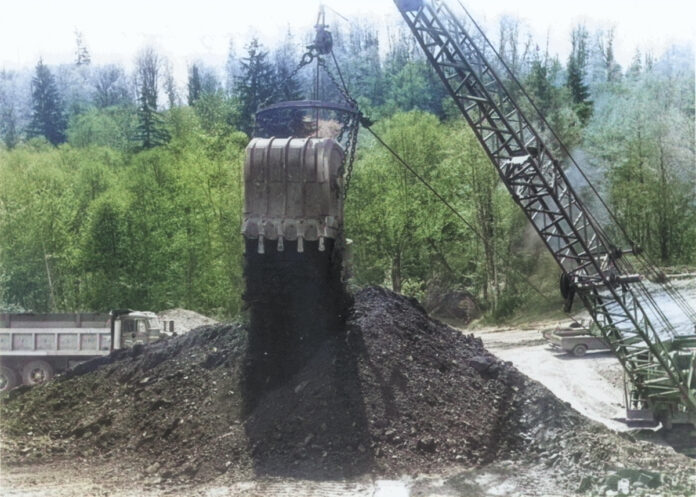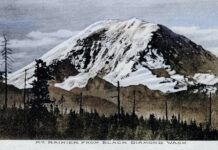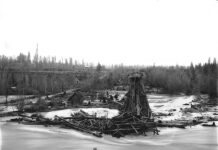Coal has been mined in South King County since 1885 after the Columbia & Puget Sound Railroad was extended up the Cedar River Valley through Black Diamond to nearby Franklin, located adjacent to the Green River Gorge. During the first 60 years, almost all mining was conducted underground through labyrinth systems of subterranean tunnels that followed the coal seams. In most parts of the country, sedimentary coal seams lay horizontally. However in the Pacific Northwest, due to the uplift of the Cascade Mountain range, the coal tilts at angles, meaning the veins of black diamonds angle anywhere from 20 degrees to 90 degrees, in the latter case vertical to the earth’s surface.
In the early days, underground mining was the only economical way to extract coal. Earthmoving equipment capable of displacing thousands of cubic yards of overburden rock didn’t exist. Underground mining methods focused on extracting the softer coal seams, leaving the surrounding bedrock in place. Plus surface mining typically required stripping ratios of perhaps 4:1 meaning four cubic yards of rock are handled for every ton of extracted coal.
By the end of World War II surface coal mining became more common after new explosives, better drilling techniques, and larger excavating equipment made it economical to move substantial amounts of earth. Mining companies were also experiencing serious labor shortages, particularly for underground miners when over 15 million men served in the armed forces.
Washington state coal mine production peaked at four million tons in 1918. In 1946, coal output had fallen 75% to one million tons, of which nine mines were open pit, though another 1.5 million tons was imported from other states. Production dropped steadily until the Centralia mine began supplying the Big Hanaford power plant in 1971. The plant still burns coal today but is expected to close in 2025.
When this photo was taken in April 1977, every underground coal mine in Washington had ceased operating. The last to close was Rogers No. 3 in Ravensdale, blasted shut in Dec. 1975. Two surface mines still operated – the Centralia Coal Mine which fed the nearby power plant generating about 10% of Washington’s electricity needs, plus the far smaller McKay mine owned by Palmer Coking Coal Co. While the Centralia mine regularly produced over four million tons per year, Palmer’s McKay operation was tiny, supplying 20,000 tons annually to heat four state institutions – Washington Correction Center near Shelton, Monroe Reformatory in Monroe, Washington Soldiers Home in Orting, and the Maple Lane School, a youth detention facility in Centralia.
This photo of the McKay surface mine looks south towards Randolph Creek, sometimes called Franklin Creek. It was located about 1/2-mile northwest of the Green River Gorge Bridge. A Koehring 405 excavator is removing coal from the McKay seam and placing it on a stockpile. A dump truck operated by Moulden & Sons, a Buckley firm associated with the coal industry is waiting to haul the raw coal to Black Diamond for processing through a wash plant to remove impurities and prepare the coal for market. The state institutions demanded stoker coal, about the size of pebbles and marbles to fuel their boiler.
This photo was colorized by Doug ‘Boomer’ Burnham, a Tahoma high school photography instructor doing business as: http://www.boomersphotography.com/ Next week, more about surface coal mining on Franklin Hill during the 1970s.







